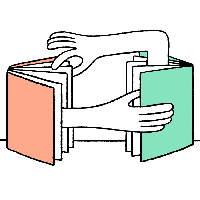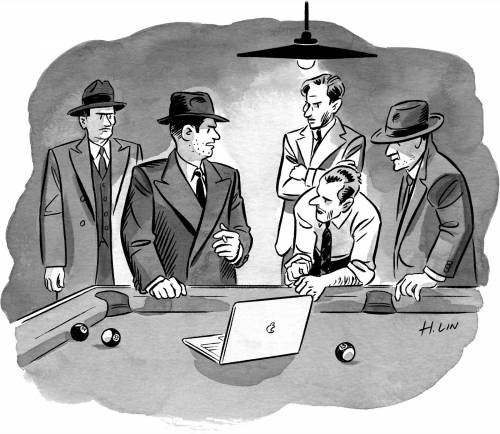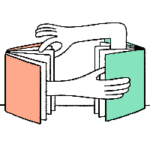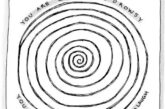Was Robert Musil right with his sardonic quip “There is nothing in this world as invisible as a monument”? Cenotaphs, triumphal arches, bronze effigies frozen in time and space: we walk right by, barely noticing them. They may commemorate events of profound human cost, but, as physical relics, they seldom touch us. Now and then, a quiet presence of stone and light can move us: Maya Lin’s Vietnam Veterans Memorial; or Daniel Libeskind’s Jewish Museum, in Berlin; or the Lincoln Memorial, with Daniel Chester French’s serene image of the seated President. But such works are in the minority. More often, monuments fail to achieve their goal of prodding us to reflect. As Musil writes, in his “Posthumous Papers of a Living Author” (1936), part of the problem may be a monument’s very permanence: “Anything that endures over time sacrifices its ability to make an impression.”
Musil was discussing physical monuments, but there are other kinds, as Jeremy Eichler shows in “Time’s Echo” (Knopf), an examination of how music can function as a vehicle for collective memory. “Sound is too visceral a medium, too penetrating of the senses to be naturalized like stone,” Eichler writes. “When music floods a room, there is nowhere to hide.” Gravely lyrical, the book is a work of vast historical scholarship and acute musical insights, and Eichler, the chief classical-music critic of the Boston Globe, is not shy about his mission, which is to demonstrate that what Thomas Mann called music’s “spoken unspokenness” gives it a unique power to memorialize in a way that engages our emotions. Eichler makes his case by scrutinizing four key mid-century works that attempted to address the catastrophe of the Second World War: Richard Strauss’s “Metamorphosen,” Arnold Schoenberg’s “A Survivor from Warsaw,” Dmitri Shostakovich’s Thirteenth Symphony, and Benjamin Britten’s “War Requiem.” Each, he claims, functions “as a carrier of memory for a post-Holocaust world.” Approaching his task “with the ears of a critic and the tools of a historian,” Eichler details the geneses of these works and their receptions, their composers’ wartime experiences, and the wider history of the war and of the Holocaust.
The Best Books We Read This Week
Read our reviews of notable new fiction and nonfiction, updated every Wednesday.

Each of these “intensely charged memorials in sound,” Eichler writes, is “a prism through which we ‘remember’ what was lost.” That’s a weighty burden to place on any piece of music, not to mention on a listener. There are many for whom nonnarrative works—Bach’s Goldberg Variations, say, or a Beethoven string quartet—represent, in their very abstraction, the epitome of pure musical meaning. For such people, this kind of musical memorializing is bound to seem uncomfortably freighted—art with an agenda, relying on extra-musical cues for its significance. Not everyone wants a musical experience to conjure images of violence and grief. Eichler seems to acknowledge this, at one point posing the question “Should genocide really be the stuff of a night out at Carnegie Hall?”
In 2001, shortly after the September 11th attacks, I found myself confronting similar questions when the New York Philharmonic asked me to compose a work to honor the victims who died in the World Trade Center. I was initially reluctant to accept. It seemed too soon: How could one create music to “commemorate” a public trauma that the nation was still processing? At the same time, it felt wrong to say no. Surely a composer ought to be able to respond to a public need; if firefighters and first responders were risking their lives at Ground Zero, the least I could do was answer the call. The resulting work, “On the Transmigration of Souls,” was agonizing to compose, not just because I spent months meeting with grief-stricken families and reading their accounts but also because I found it nearly impossible to fix on a voice for the piece. The media was still hectically recycling images of the catastrophe, to the point where any real meaning had been leached from them. In the end, I made what I termed a “memory space”—a mostly quiet piece for orchestra and a chorus of adults and children which incorporated prerecorded sounds of the city and the murmured recitation of names and phrases from missing-persons signs. The piece had its première on September 19, 2002, almost exactly a year after the event that prompted it—paired with Beethoven’s Ninth Symphony, that most famous of Enlightenment narratives, which carries its listener from minor-key struggle to major-key victory.
There is no such victorious exultation in the four works that Eichler examines. Two address the Holocaust specifically: Schoenberg’s “A Survivor from Warsaw,” a blunt and graphic piece for narrator, men’s choir, and orchestra, relates the experiences of a survivor of the Warsaw Ghetto in a concentration camp; Shostakovich’s Thirteenth Symphony opens with a setting of Yevgeny Yevtushenko’s poem “Babi Yar,” remembering the Nazis’ massacre of Jews in Kyiv, in 1941. Strauss’s “Metamorphosen,” scored for twenty-three solo strings, is the only one of the four pieces that has no text, and is the most inward-looking, unfolding as a seamless half-hour lament. Britten’s “War Requiem,” by far the longest, is a huge cantata of public grieving.
It’s difficult today to imagine a composer of classical music commanding the kind of attention that these four enjoyed. Shostakovich was only nineteen when his First Symphony made him famous, and from then on premières of his large-scale works were significant events in the Soviet Union. Britten deliberately mined a deep vein of English experience and became one of his country’s most beloved composers. And Strauss, in Germany and Austria, was seen as the inheritor of the great lineage dating back to Bach—the living embodiment of what Eichler calls “the stupendously overdetermined relationship between Germans and music.” Only Schoenberg, whose atonal music was forever at odds with convention, remained an outlier. Yet, paradoxically, it was he, not the other three, who would emerge as the model for much of the following postwar generation of avant-garde composers.
The four composers experienced the Second World War in radically different ways. Strauss remained in Germany and Austria, his reputation forever sullied by his ambivalent relationship with the Nazi regime. Schoenberg watched helplessly from his home in Los Angeles, having fled Europe in 1933, when Hitler came to power. Shostakovich was a volunteer firefighter during the siege of Leningrad. His Seventh Symphony, written in the midst of the conflict, essentially live-streamed the city’s resistance to the German assault. Britten, a pacifist, left England for America shortly before the outbreak of war (a decision some of his compatriots never forgave) but returned in 1942; registering as a conscientious objector, he was exempted from military service and spent the rest of the war working on the opera that was to make him famous, “Peter Grimes.”
Of the four, Strauss’s story is the most uncomfortable to contemplate. Achieving fame in the late nineteenth century, while still a young man, he demonstrated a Nietzschean skepticism toward the lofty Bildung ideals of nineteenth-century German art and philosophy. In contrast to the spiritually questing emotional roller coasters of his contemporary Gustav Mahler’s symphonies, Strauss’s works were the product of an artistic personality that toggled between studied irony and a bourgeois sentimentality seemingly custom-cut to Wilhelmine sensibilities. He could shock and thrill, as with his two blood-and-gore operas, “Salome” (1905) and “Elektra” (1909), but it was the plush period-piece romanticism of “Der Rosenkavalier” (1911), with its lilting waltzes and luscious female roles, that brought his popularity to its peak.
Amid the advent of National Socialism, Strauss was one of many cultural figures who found themselves performing a complex dance with the Nazis. He had Jewish family members (his daughter-in-law’s family and his grandchildren) whom he wanted to protect, not to mention Jewish friends and colleagues. He may have considered himself apolitical, but there was no escaping Hitler, who—disturbing as it is to realize—was quite possibly the most musically knowledgeable head of state ever. The Führer knew his Beethoven and his Wagner, and he maintained an almost boyish enthusiasm for opera productions that had thrilled him in his youth. Thus, for Strauss, there was no declining an invitation, in 1933, to become president of the newly created Reich Music Chamber, conceived by Joseph Goebbels as a means of purging German music of “cosmopolitan” (that is, Jewish) influences.
What followed was a distressing sequence of gestures on Strauss’s part, from the trivial—composing a song, “Das Bächlein,” that he dedicated to Goebbels—to the odious: he agreed to conduct a Berlin Philharmonic concert after the Jewish conductor Bruno Walter had been dismissed and likewise filled in at the Bayreuth Festival when Arturo Toscanini, an ardent antifascist, refused to conduct there. But Strauss’s attempts to compartmentalize art and life were ultimately doomed to fail. Even Germany’s greatest composer could not save his Jewish daughter-in-law and her children from harassment and her grandmother from dying in the Theresienstadt concentration camp.
Strauss completed “Metamorphosen” in the final months of the war. Unusually for a composer whose early fame came from explicitly pictorial pieces such as “Don Quixote” and “Till Eulenspiegel,” it depicts nothing concrete. If it is “about” something, it is about pure emotion, deeply felt with long, aching melodic lines and roving, shape-shifting harmonies. A lot of ink has been spilled imagining a backstory to this music. Its unmistakably private emotions combined with an enigmatic quotation from the funeral march in Beethoven’s “Eroica” Symphony make it nearly impossible not to suppose a link to the disasters that engulfed Strauss at the end of his life. Eichler calls the piece “a death mask in sound,” but one can come away with a less bleak impression. Online, there’s a performance of the work by the Norwegian Chamber Orchestra, in which the musicians, barefoot and playing from memory, produce a feeling of renewal—perhaps of one of the souls in an Ovid myth questing toward rebirth.
“Metamorphosen” and “A Survivor from Warsaw” were completed two years apart, when both composers were old men. If “Metamorphosen” is a work of intimate grieving, “A Survivor from Warsaw” is a scream of terror. Some seven minutes long, it is highly compressed both musically and dramatically. It sets a short, disturbingly graphic text, based on reports of Holocaust survivors, that describes a horrific scene of Jews threatened, brutalized, and prepared for the gas chamber. At the close of the piece, the Jews rise up in defiance, singing in unison the Hebrew prayer Shema Yisrael. Eichler sees this moment as a metaphor for Schoenberg’s own life; he was a nonpracticing Jew who, under threat of annihilation, realized and then proclaimed his identity. It is a work, Eichler says, that “actively denies comfort or any facile sense of closure.”
Schoenberg left for America the same year as Thomas Mann, and both ended up in Southern California, but, whereas Mann was a Nobel laureate with an international audience, Schoenberg had to support himself and his family by teaching. “There is nothing I yearn for more intensely . . . than to be taken for a better sort of Tchaikovsky,” he lamented, but his music was rarely performed, except for his early tonal works. So traumatized was he by the rise of antisemitism, and by the collapse of the German culture he’d held so precious, that he resolved to focus his energy on rallying all Jews to the cause of creating a new Jewish state.

“Boss wants us to send a strong message, so we’re gonna write a well-informed, cohesive op-ed.”Cartoon by Hartley LinCopy link to cartoonCopy link to cartoon
ShopShop
Theodor Adorno, famously critical of any artistic representation of the Holocaust, made an exception for “Survivor,” acknowledging its willingness to confront the worst in human behavior. And confrontational it certainly is, with its jagged dissonances, shrieking instrumental effects, and frantic shouting in English and German by the narrator. It is one of the most psychologically painful artistic experiences I know of, and because its violence comes to us in the form of sound it feels far more viscerally assaultive than, say, Picasso’s “Guernica.” Conductors, on the rare occasions they decide to perform it, are often at a loss as to how to contextualize it on a program. As often as not, they default to Beethoven’s Ninth.
If the Strauss and Schoenberg pieces form something of a pair, two cries of pain from the war’s immediate aftermath, so do Shostakovich’s Thirteenth Symphony and Britten’s “War Requiem.” Both dating from 1962, they inevitably have a more retrospective cast, to some extent refashioning what they memorialize and, in the case of the Shostakovich, actively challenging an official version of events. Shostakovich’s creative life played out entirely during the Soviet era, his output alternately hailed and condemned by the authorities. Like Strauss, he was often forced into uncomfortable accommodations with political circumstances, and, in 1960, he joined the Communist Party, a compromising gesture that devastated his admirers. Sofia Gubaidulina, a young composer who adored him, later recalled, “That such a man could be broken, that our system was capable of crushing a genius, was something I could not get over.” But in the end she accepted it, seeing Shostakovich “as pain personified, the epitome of the tragedy and terror of our times.”
The Thirteenth Symphony emerged during the so-called post-Stalinist thaw of Nikita Khrushchev, but it greatly annoyed the regime, opening as it does with men’s voices intoning Yevtushenko’s poem in memory of the Jews murdered at Babi Yar:
There is no memorial above Babi Yar.
The steep ravine is like a coarse tombstone.
I’m frightened,
I feel as old today
as the Jewish race itself.
I feel now that I am a Jew.
Yevtushenko’s text had been published just the year before, in 1961, but it was already familiar to poetry-loving Russians. It confronted the Soviet narrative of the massacre, which suppressed the identity of the victims, refusing to single out the Jews from all those who died in “the heroic struggle of the Russian people.” Yevtushenko, yielding to the threat of censure, revised his poem. He took out the line “I feel now that I am a Jew” and replaced “Here I hang on the cross and die / And I still bear the mark of the nails” with “Here Russians lie, and Ukrainians / Together with Jews in the same ground.” Shostakovich, disappointed by Yevtushenko’s revision, initially refused to change the music to accommodate the more politically acceptable phrases.
In Shostakovich’s theatrically emphatic setting, the music oscillates threateningly between a plodding, funereal grind and a crazed dance infused with bitter irony. I can’t quite share Eichler’s awe of the piece. For all its sincerity, the evocation of Babi Yar has an unfortunate feel of movie music. Neither the singers’ chest-pounding protestations of solidarity with the Jews nor the sarcastic music summoning images of “fine ladies with lace frills [who] squeal and poke their parasols into my face” is free of the aura of entertainment. It strikes me as falling exactly into the trap that Adorno warned about when he wrote of art and the Holocaust.
For decades, the symphony remained all but unperformable in the Soviet Union. By contrast, Britten’s “War Requiem” arose from an official commission to celebrate the rebuilding of Coventry Cathedral, which had been destroyed in 1940, during the Blitz. But there was a personal aspect, too, because of Britten’s very public pacifism and the resentment that it had earned him. With the “War Requiem,” he produced a work that voiced revulsion toward bloodshed while still satisfying the public need for a huge, unifying utterance of national remembrance. A performance of the piece requires hundreds of musicians; a grainy film of a 1964 BBC telecast from the Royal Albert Hall, with the composer acting as one of two conductors, has the look of a packed soccer stadium.
Britten’s great inspiration was to take the traditional Requiem Mass and embed within it texts by Wilfred Owen, an English poet of the First World War, who was killed in action only days before the 1918 Armistice. Owen, like Britten, was gay, and his works, by then revered in England, gave powerful voice to the composer’s loathing of war. The poems are painfully intimate, and, in Britten’s setting, their stark images of broken bodies and the machinery of death create a disturbing contrast with the solemn, oracular Latin of the Mass.
Britten and Shostakovich admired each other’s work, and became friends after they met, in 1960. Both “War Requiem” and the Shostakovich symphony are written in a musical language that manages to be both original and easily digestible for the average listener. Their modes of expression—tonal, rhythmically simple, structured around familiar gestures—recall Verdi or medieval church music. In this, both composers were out of step with the high-modernist experimentalism that held sway in Europe and the U.S. By the early fifties, composers such as Pierre Boulez, Karlheinz Stockhausen, and John Cage had adopted a severe, mechanistic approach to musical composition, much of it governed by coolly rational systems and procedures.
This may be one reason for something that struck me forcibly as I was trying to fulfill the New York Philharmonic’s 9/11 commission: America had no contemporary musical work that could express national trauma. We Americans seem to have a popular song for just about every emotion, but in the immediate aftermath of tragedy only classical music seemed able to fill the void. I remember the afternoon of President Kennedy’s assassination vividly, because the Boston Symphony Orchestra, whose live broadcasts I listened to as a teen-ager, interrupted its planned program to play the funeral march of Beethoven’s “Eroica,” the piece that Strauss quoted in “Metamorphosen.” In the aftermath of 9/11, the New York Philharmonic played Brahms’s German Requiem.
Both pieces were well chosen—lyrical, noble, intensely moving in their quiet restraint. Still, it troubled me that the U.S., with its incredible wealth of all kinds of music, did not have a single work comparable in scale and substance to “War Requiem” or “Metamorphosen.” There were short, intimate pieces, such as Aaron Copland’s “Quiet City” or Samuel Barber’s “Adagio for Strings,” both affecting statements couched in a characteristically simple American mode. But for whatever reason we lacked a work of the kind of gravitas that the European canon was rich with.
I had no aspirations to fill that void. It would have been a fool’s mission even to try. My only wish was to somehow acknowledge the sense of loss that such a calamity wrought on those who lost their loved ones. I aimed to go as far as possible in the opposite direction from the loud, unfeeling chatter on the television. But how to frame this musically without sensationalizing, without hand-wringing? The breakthrough for me was the idea of embedding the hymnlike harmonies of Charles Ives’s sublime “The Unanswered Question” within my music.
Ives gives this hushed hymn to a string orchestra, playing pianississimo throughout. A lone trumpet, seeming to come from another planet, asks “the question” repeatedly—five notes without a text but full of numinous meaning. A dissonant chatter of woodwinds attempts to give an answer but, failing, gives up. Ives suggests that these three elements be spatially separated from one another, and I took that as a cue, surrounding my audience with a similarly hushed “cityscape” of ambient sounds over a delicate orchestral haze of refracted sonic images. I’d seen a video of millions of pieces of paper and debris floating down from the towers in the moments before they collapsed, and its eerie beauty reminded me of a gentle snowstorm. In my piece, a chorus with children sings the words of a woman who lost her husband: “I loved him from the start, I wanted to dig him out, I know just where he is.” The music wells up in a brief tsunami of sound, with the chorus reiterating sentence fragments: “Light . . . Sky . . . Day . . .” The chaos settles and the Ivesian harmonies emerge slowly, like the image of something coming through dense fog. We hear a young woman saying, “I see water and buildings.” It’s a quote from a frantic flight attendant on one of the planes careening toward the World Trade Center, but is now rendered with quiet restraint. In fact, I’d recorded my teen-age daughter reading the words.
The piece was received with respect, but whether it was experienced by the audience as akin to one of Eichler’s “intensely charged memorials in sound” I do not know. What remains in my mind are the appreciative but puzzled faces of the families of the victims who attended the performance. They were the ones I really cared about. “They didn’t get it,” I said to myself in remorse. The breach between their experience and mine, no matter how hard I’d tried to close it, remained unbridgeable. ♦
Sourse: newyorker.com






